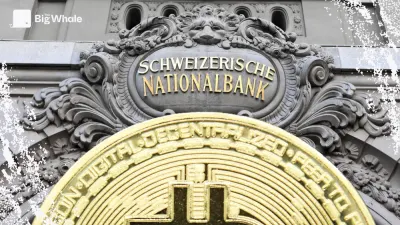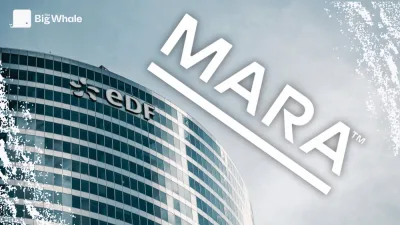TBW - Ethereum Foundation: An essential but contested organisation

What is the Ethereum Foundation?
The Ethereum Foundation (EF) is a non-profit organisation founded on 6 July 2014 in Bern, Switzerland, with the aim of promoting, developing and perpetuating the Ethereum ecosystem. It is now based in Zug, also in Switzerland, like many other foundations in the sector. The foundation was launched following an Initial Coin Offering (ICO) that raised around $18 million. This money was used to finance the initial development of Ethereum and to lay the foundations of an infrastructure capable of hosting future innovations.
The Ethereum Foundation is positioning itself as a central player in the development of the protocol, although it presents itself as a simple facilitator. In particular, it funds research and development of the protocol - particularly with the transition in 2022 to Ethereum 2.0 and the adoption of Proof of Stake (PoS) - as well as scaling solutions such as rollups. The foundation also funds projects via the Ecosystem Support Program (ESP), helping initiatives such as Uniswap and Optimism to develop. Despite this official view of passive support, its role is far from neutral, as it effectively steers the direction Ethereum takes through its funding and strategic priorities.
Who are its leaders and how are they appointed?
The Ethereum Foundation is led by a small circle of members, including Japan's Aya Miyaguchi, executive director since 2018. She plays a key role in allocating funds and defining strategic priorities. It should be noted that the EF does not have a traditional governance structure such as a company with an elected board or a formal process for appointing officers. Its executive members are chosen on the basis of their leadership and via an opaque internal selection process.
The foundation's current board is made up of Aya Miyaguchi, Swiss lawyer Patrick Storchenegger and Ethereum co-creator Vitalik Buterin.
The latter has enormous influence over the foundation, but it is not the classic operational influence of a CEO. He doesn't run the foundation on a day-to-day basis, but he is its principal architect. He has three of the five votes on the Ethereum Foundation's board of directors, so in reality he makes all the major strategic decisions. He's the one who chooses the executive director, he's the one who sets the broad direction. He doesn't deal with day-to-day management, but if a major decision has to be taken, it necessarily goes through him.
His role has also evolved over time. A few years ago, he was more active in technical debates and intervened more frequently on development issues. Today, he is more of a visionary and guarantor of Ethereum's fundamental principles. He remains one of the biggest assets of the ecosystem, because his influence is global. When Vitalik Buterin supports an idea, it carries weight, whether with developers, institutions or even regulators. He has this unique ability to articulate a vision that inspires and attracts the best talent to Ethereum.
Other central figures include researchers such as Danny Ryan, Tim Beiko, Dankrad Feist and Justin Drake, who are actively working on improvements to the protocol.
What real influence does the Ethereum Foundation have in Ethereum's development strategy?
The Ethereum Foundation plays a key role in guiding the protocol, but it does not have absolute power. Its influence lies mainly in funding research and supporting the teams developing Ethereum. It structured and financed work on Proof of Stake, sharding and the development of layer 2. It does not directly decide on updates, but by funding researchers and supporting certain areas of development, it clearly guides strategic choices.
However, it does not control everything. Ethereum works with several independent clients (Geth, Nethermind, Besu, Erigon), developed by different teams that make their own decisions. The Core Devs Meetings are the real forum for technical discussion, and the Foundation does not impose its choices. What's more, as the ecosystem grows, its influence diminishes: players such as Optimism or zkSync now fund their own research and development, which reduces dependence on the Foundation.
The Ethereum Improvement Proposals (EIPs), which are not filtered by the Foundation, are also other initiatives that make it possible to assess its relative control over improvements to the protocol. Anyone can propose an EIP, present it publicly and have it discussed by the community and Core Devs. Final decisions on Ethereum updates go through a transparent process where several teams of Ethereum client developers have to agree.
The example of the Proof of Stake (The Merge) illustrates this process well. The transition was foreseen as early as the 2015 whitepaper, but its implementation has been extensively debated and refined through several PIEs. Other key developments (such as EIP-1559, which introduced the transaction fee burn) were widely discussed before being adopted.
Why is its cash management criticised?
As of 31 October 2024, the Ethereum Foundation has cash of $970.2 million, split into $788.7 million in crypto-currencies and $181.5 million in non-crypto assets. The majority of these crypto holdings (99.45%) are ETH, representing approximately 0.26% of the total ETH supply in circulation at that date.

The Ethereum Foundation's ETH sales are raising criticism about their impact on the market and their strategic relevance. One of the most debated points is their influence on the ETH price. On several occasions, major sales have coincided with price falls, fuelling suspicions of possible market timing, intentional or otherwise, on the part of the Foundation. Given the quantity of ETH it holds - around 0.26% of the total supply in circulation in 2024 - any major sale can lead to downward pressure, especially if it is executed in an illiquid market. These movements are particularly closely watched by the community, as they can send negative signals to investors, suggesting that the Foundation is seeking to offload its ETH holdings at key moments in the market. Greater transparency on the sales strategy, with long-term planning and clearer communication, could alleviate these concerns.
Another major criticism concerns the Foundation's cash management itself. Rather than regularly selling ETH to fund its activities, it could exploit alternative mechanisms that would avoid creating selling pressure on the market. One of the most obvious solutions would be staking its ETH. With the transition to Ethereum 2.0 and the introduction of Proof of Stake, the Foundation now has the opportunity to generate passive returns by securing the network. However, it does not seem to be taking full advantage of this opportunity. By staking its reserves, the Foundation could generate a regular income stream without directly touching its capital.
Beyond staking, an alternative would be to use DeFi platforms to borrow stablecoins by pledging its ETH as collateral. Protocols such as Aave or MakerDAO make it possible to obtain liquidity without selling one's assets, which would avoid creating pressure on the market while funding the Foundation's initiatives. This type of active cash management is already commonly used by crypto investment funds and DAOs, but the Ethereum Foundation still seems to favour a more traditional approach, directly liquidating part of its reserves. Official reason: neutrality. It does not want to give the impression of favouring applications in the ecosystem to the detriment of others.
>> Read also - Jérôme de Tychey: "My proposals for the Ethereum Foundation"
What is the breakdown of its expenditure?
In 2022, the Foundation allocated $105.4 million, mainly to fund research projects, support community development and support autonomous institutions. In 2023, this expenditure increased by 28% to $134.9 million. The report for 2024 was still not available at the beginning of February 2025.

It places a major emphasis on Layer 1 research and development, devoting 30.4% of its budget in 2022 ($32.1 million) and 25.7% in 2023 ($34.7 million) to this category, a proportional decrease reflecting a diversification of priorities while maintaining Layer 1 as a fundamental pillar of the network.
At the same time, Zero-Knowledge (ZK) technologies have become an increasingly important part of its strategy, with the budget rising from $7.6 million in 2022 (7.2%) to $14.8 million in 2023 (11%), in order to strengthen the confidentiality and scalability of transactions on Ethereum through projects such as Semaphore and MACI.
Support for autonomous institutions has also increased significantly, from 28.6 million in 2022 (27.1% of the budget) to 47.4 million in 2023 (35.2%), illustrating the Foundation's growing commitment to decentralisation with initiatives such as L2BEAT and 0xPARC.
In parallel, community development received $19.5 million in 2022 (18.5% of the budget), but saw its funding reduced to $16.9 million in 2023 (12.5%), while continuing to support key events such as Devcon and Devconnect.
Finally, the Foundation has maintained its investment in developer tools, with support for key infrastructures such as Solidity and Remix IDE, receiving $8.3 million in 2022 (7.9% of the budget) and $8.7 million in 2023 (6.5%) respectively, to encourage the creation and adoption of decentralised applications.
Audit and financial transparency of the Ethereum Foundation
The Ethereum Foundation (EF) regularly publishes financial reports to ensure a degree of transparency vis-à-vis the community, investors and its partners. These reports, which can be accessed on the Foundation's official website, provide an overview of income, expenditure, investments and budget allocations.
However, while these publications make it possible to monitor the EF's major financial trends, they often lack details on the precise allocation of funds. The Foundation devotes a significant portion of its budget to funding research projects, network infrastructure-related initiatives and strategic investments, but the exact tracking of this spending remains unclear.
In 2023, the Ethereum Foundation announced a budget of $130 million, with a focus on research and development, network security and support for decentralised institutions. However, financial reports do not always provide a detailed breakdown of the funds allocated to each specific project. For example, while it is known that several initiatives have received funding, it is difficult to identify precisely how much has been allocated to each programme or partner.
While the Ethereum Foundation shows a commitment to transparency by publishing its annual reports, grey areas persist as to how funds are distributed. In particular, information on administrative expenses, salaries and the distribution of grants remains limited.
Between 2022 and 2023, the EF allocated around $500 million in grants, but without any detailed indication of the breakdown of these amounts. For example, internal spending by department or specific investments in certain projects are rarely detailed. Similarly, investments in external entities, such as startups linked to the Ethereum ecosystem, are not systematically accompanied by precise explanations of the amounts committed or the allocation criteria.
In 2024, the situation remains unchanged. The financial reports remain consolidated, offering a macro view of the use of funds, but without providing details of internal financial flows and budgetary decision-making.
For example, the Foundation allocated ETH 50,000 to support the DeFi ecosystem via multi-signature portfolios. However, the reports do not specify how these funds were distributed between the various beneficiary platforms and projects. This opacity raises questions about the organisation's financial governance and its ability to justify its investment choices.
As the Ethereum ecosystem continues to grow and attract more and more funding, the issue of budget transparency is becoming crucial. Several players in the sector believe that the Ethereum Foundation should publish more detailed reports, specifying in particular:
- The breakdown of grants by project and beneficiary.
- The exact amounts invested in partner companies and the associated conditions.
- A clarification of administrative expenses and internal remuneration.
What is its internal policy to prevent conflicts of interest?
Researchers Justin Drake and Dankrad Feist have been at the centre of controversy in 2024 due to their role as advisors to the EigenLayer restaking project, raising questions about the organisation's neutrality and governance.
In response, the Foundation introduced its first anti-conflict of interest policy at the end of 2024 to ensure the integrity of the organisation while allowing its members, known as "EFers", to be active in the crypto ecosystem.
They can freely invest in liquid crypto assets, but must inform the foundation for any investment over $500,000, except for ETH. Excessive exposure to an asset may result in withdrawal from decisions related to that asset or other mitigating actions. For other potential conflicts of interest, an internal discussion group comprising EF management, team leader, legal and human resources review each situation to assess the risks and benefits. In some cases, restrictions such as an obligation to recuse oneself or outright refusal may be imposed.
As regards work outside the EF, it is authorised subject to informing the foundation, and any paid activity in excess of $25,000 per year must be validated by the discussion group. Investments as angel investors are possible, but subject to a limit of $100,000 per investment and $400,000 per year, with a requirement for prior information and approval. Similarly, EFers may invest in funds or co-found projects, provided they inform the EF, and these are subject to regular evaluation and monitoring to avoid any incompatibility with their role. However, it is strictly forbidden to receive remuneration in illiquid assets whose market value is unknown, with "rare exceptions".
This policy only concerns conflicts related to the crypto and Web3 ecosystem and requires EFers to update their declarations of interest with management on an annual basis. It applies to all employees and contractors, whether full-time or part-time, but excludes interns, fellows, grant recipients and certain advisers. With these new rules, the EF is seeking to balance its members' involvement in the crypto ecosystem while preserving its neutrality and credibility.



